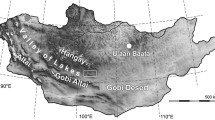Abstract
Current large-scale mammalian diversity patterns in Canada can be accurately explained using various measurements of heat energy. Unfortunately, climatic change is predicted to alter the fundamental climatic basis for contemporary diversity gradients, with the expected consequence that much of the Canadian biota will need to migrate in order to remain within climatically suitable regions. We make predictions regarding future mammal diversity patterns in Canada, and therefore provide a preliminary indication of where management intervention should be directed in order to conserve mammal diversity as climate changes. We also examine the current distributions of individual mammal species in Canada in order to determine which taxa cannot migrate farther north because of the Arctic Ocean barrier. Of the 25 species that fall into this category, we examine the predicted loss of habitat in one keystone species – Dicrostonyx groenlandicus, the collared lemming – and find that this taxon is likely to lose approximately 60% of its habitat with unpredictable but likely detrimental consequences for the arctic biota. We discuss the implications of our findings briefly.
Similar content being viewed by others
References
Adams, J. M. and Woodward, F. I.: 1989, Patterns in tree species richness as a test of the glacial extinction hypothesis, Nature 339, 699.
Cox, B. C. and Moore, P. D.: 1985, Biogeography: An Ecological and Evolutionary Approach, Blackwell Scientific, Oxford, U.K.
Currie, D. J.: 1991, Energy and large-scale patterns of animal and plant species richness, Am. Nat. 137, 27.
Currie, D. J. and Paquin, V.: 1987, Large-scale biogeographic patterns of species richness of trees, Nature 329, 326.
Davis, M. B.: 1990, Biology and paleobiology of global climate change: Introduction, TREE 5, 269.
Dobson, A., Jolly, A. and Rubenstein, D.: 1990, The greenhouse effect and biological diversity, TREE 4, 64.
Forsyth, A.: 1985, Mammals of the Canadian Wild, Camden East Publishing, Camden East, Ontario.
Graham, R. W.: 1992, Late Pleistocene Faunal Changes as a Guide to Understanding Effects of Greenhouse Warming on the Mammalian Fauna of North America, in: R. L. Peters and T. E. Lovejoy (eds.), Global Warming and Biological Diversity, Yale University Press, New Haven, Connecticut, pp. 76–87.
Graham, R. W. and Grimm, E. C.: 1990, Effects of global climate change on patterns of terrestrial biological communities, TREE 5, 289.
Hall, E. R. and Kelson, K. R.: 1981, The Mammals of North America, John Wiley & Sons, Toronto, Canada.
Houghton, J. T., Meira Filho, L. G., Bruce, J., Hoesung Lee, Callander, B. A., Haites, E., Harris, N. and Maskell, K.: Climate Change 1994: Radiative forcing of climate change and an evaluation of the IPCC IS92 Emission Scenarios, published for the Intergovernmental Panel on Climate Change (IPCC), Cambridge University Press, Cambridge, U.K.
Kerr, J. T. and Currie, D. J.: 1995, Effects of human activity on global extinction risk, Conservation Biology 9, 1528.
Kerr, J. T. and Packer, L.: 1997, Habitat heterogeneity as a determinant of mammal specices richness in high energy regions, Nature 385, 252.
MacArthur, R. H.: 1972, Geographical Ecology, Harper and Row, New York, New York.
Melillo, J.M., Callaghan, T. V., Woodward, F. I., Salati, E. and Sinha, S. K.: 1991, in: J. T. Houghton, G. J. Jenkins and J. J. Ephraums, (eds.), Climate Change: The IPCC Scientific Assessment. Cambridge University Press, New York, New York, pp. 283–310.
Myers, N.: 1992, Synergisms: Joint Effects of Climate Change and Other Forms of Habitat Destruction, in: R. L. Peters and T. E. Lovejoy (eds.), Global Warming and Biological Diversity, Yale University Press, New Haven, Connecticut, pp. 344–354.
Pacala, S.W. and Hurtt, G. C.: 1993, Terrestrial Vegetation and Climate Change: Integrating Models and Experiments, in: P. M. Kareiva, J. G. Kingsolver and R. B. Huey (eds.), Biotic Interactions and Global Change. Sinauer Associates, Sunderland, Massachusetts, pp. 57–74.
Pace, M. L.: 1993, Forecasting Ecological Responses to Global Change: The Need for Large-Scale Comparative Studies, in: P. M. Kareiva, J. G. Kingsolver and R. B. Huey (eds.), Biotic Interactions and Global Change, Sinauer Associates, Sunderland, Massachusetts, pp. 356–365.
Peters, R. L.: 1987, Effects of Global Warming on Biological Diversity: An Overview, in: Proceedings of the First North American Conference on Preparing for Climate Change: A Cooperative Approach, Government Institutes, Inc. Washington, D.C., pp. 169–185.
Peters, R. L.: 1992, Conservation of Biological Diversity in the Face of Climate Change, in: R. L. Peters and T. E. Lovejoy (eds.), Global Warming and Biological Diversity, Yale University Press, New Haven, Connecticut, pp. 15–26.
Peters, R. L. and Darling, J. D.: 1985, The greenhouse effect and nature reserves, BioScience 35, 707.
Quinn, J. F. and Karr, J. R.: 1993, Habitat Fragmentation and Global Change, in: P. M. Kareiva, J. G. Kingsolver and R. B. Huey (eds.), Biotic Interactions and Global Change, Sinauer Associates, Sunderland, Massachusetts, pp. 451–465.
Raven, P. H.: 1988, Our Diminishing Tropical Forests, in: E. O. Wilson (ed.), Biodiversity, National Academy Press, Washington, D.C., pp. 119–122.
Russell, G. L., Miller, J. R. and Rind, D.: 1996, A coupled atmosphere-ocean model for transient climate change studies, Atmos. Ocean 33, 683.
Soulé, M. E.: 1992, Foreward: The Wrong Time for Climate Change, in: R. L. Peters and T. E. Lovejoy (eds.), Global Warming and Biological Diversity, Yale University Press, New Haven, Connecticut. pp. xiii-xv.
Wilson, E. O.: 1988, The Current State of Biological Diversity, in: Edward O. Wilson (ed.), Biodiversity, National Academy Press, Washington, D.C., pp. 3–17.
Author information
Authors and Affiliations
Rights and permissions
About this article
Cite this article
Kerr, J., Packer, L. The Impact of Climate Change on Mammal Diversity in Canada. Environ Monit Assess 49, 263–270 (1998). https://doi.org/10.1023/A:1005846910199
Issue Date:
DOI: https://doi.org/10.1023/A:1005846910199




